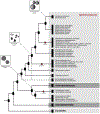Fantastic yeasts and where to find them: the hidden diversity of dimorphic fungal pathogens
- PMID: 31181385
- PMCID: PMC11227906
- DOI: 10.1016/j.mib.2019.05.002
Fantastic yeasts and where to find them: the hidden diversity of dimorphic fungal pathogens
Abstract
Dimorphic fungal pathogens are a significant cause of human disease worldwide. Notably, the dimorphic fungal pathogens within the order Onygenales are considered primary pathogens, causing disease in healthy hosts. Current changes in taxonomy are underway due to advances in molecular phylogenetics, population genetics, and new emerging dimorphic fungal pathogens causing human disease. In this review, we highlight evolutionary relationships of dimorphic fungal pathogens that cause human disease within the order Onygenales and provide rationale to support increased investment in studies understanding the evolutionary relationships of these pathogens to improve rapid diagnostics, help identify mechanisms of antifungal resistance, understand adaptation to human host, and factors associated with virulence.
Copyright © 2019 Elsevier Ltd. All rights reserved.
Conflict of interest statement
Conflict of interest statement
Nothing declared.
Figures



 ) and Blastomyces (
) and Blastomyces ( ) adapted from Ref. [53]. (Illustration created with BioRender).
) adapted from Ref. [53]. (Illustration created with BioRender).References
-
- Taylor JW, Jacobson DJ, Kroken S et al.: Phylogenetic species recognition and species concepts in fungi. Fungal Genet Biol 2000, 31:21–32. - PubMed
Publication types
MeSH terms
Grants and funding
LinkOut - more resources
Full Text Sources
Medical

